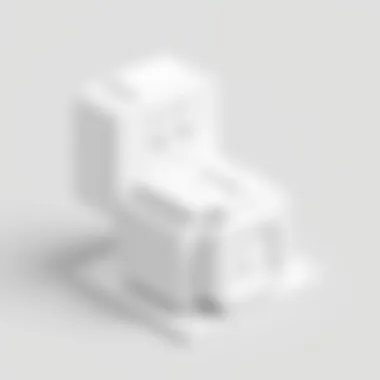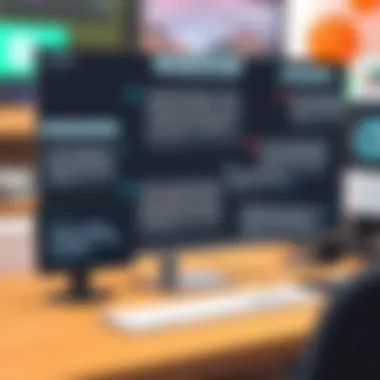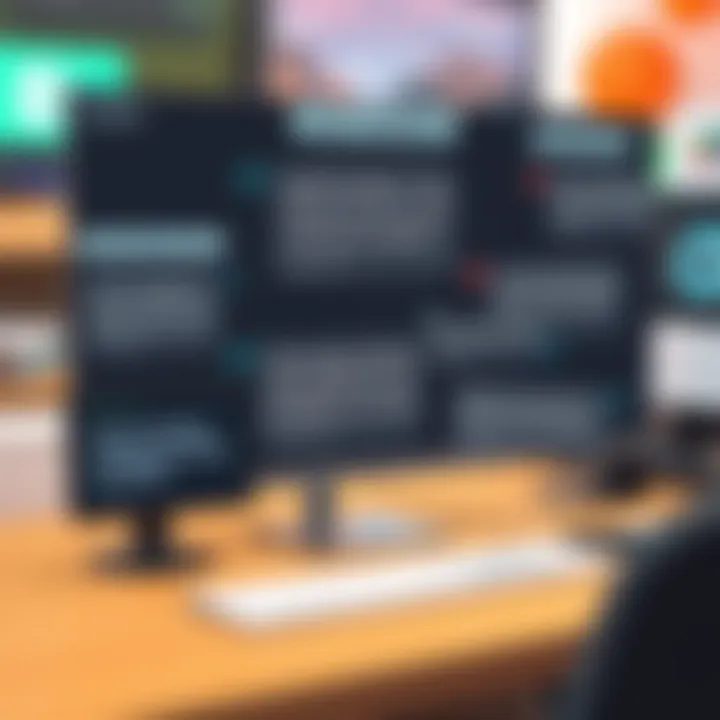Top 3D Editors for 3D Printing: A Detailed Overview


Intro
In a world increasingly driven by technological advancements, 3D printing has emerged as a fascinating avenue for creativity, innovation, and practical applications. As more people from various fields—be it engineering, art, or even education—venturing into this realm, the demand for effective 3D editing software escalates. Selecting the right tools can often seem daunting, especially with the array of options available. This guide endeavors to clarify the landscape of 3D editing tools that specialize in 3D printing, to help users make informed choices.
The variety is breadth and varied, catering to different preferences and skill levels. From seasoned professionals churning out intricate designs to hobbyists crafting simple prototypes, there’s a software option that fits every need. As we navigate through this guide, we will dissect product overviews, gauge performance in specific scenarios, and delve into the unique features that define today's leading 3D editors. Ensuring that users, whether novice or aficionado, can sift through the plethora of choices to find software that not only meets their needs but also resonates with their creative vision.
With software continually evolving, blending sophisticated functionalities with user-centric designs, this guide aims to parse through all of it, emphasizing key points that matter to potential users. Each section promises to shine a light on user experiences and expert insights, imprinting a clearer image of the strengths, limitations, and remarkable traits that each tool embodies. So, let’s roll up our sleeves and dive straight into understanding what defines the very best in the business.
Understanding 3D Editors
When it comes to bringing creative visions to life through 3D printing, understanding the ins and outs of 3D editors is key. These tools serve as the backbone for designing the intricate models that will eventually materialize as physical objects. In this guide, we’ll dive deep into what makes a 3D editor tick, examining various software options tailored for diverse user needs. This focus on 3D editors is crucial since they not only streamline the design process but also enhance the efficiency of translating ideas into tangible products.
Overview of 3D Editing Software
3D editing software encompasses a vast range of tools capable of transforming a concept into a three-dimensional model. Think of it as a digital workshop, where different functionalities enable users to construct and refine their designs. These editors come equipped with features that allow users to add intricate details, modify shapes, and adjust textures. For example, some might prefer modeling software like Blender, which offers robust sculpting tools and extensive customization options, while others might lean toward simplified platforms like Tinkercad, which caters especially to beginners.
Key components of these editors typically include:
- Modeling Tools: Create geometric shapes and edit them.
- Sculpting Capabilities: Allow for more organic shapes and features.
- Rendering Options: Visualize the final product before printing.
User demands and project specifications often dictate the choice of software, be it for architecture, game design, or personal projects.
Importance for 3D Printing
The significance of 3D editors in the realm of 3D printing cannot be overstated. A poorly crafted model can lead to failed prints or unsatisfactory results. Thus, selecting the right editor contributes directly to maximizing output quality. 3D editors such as Fusion 360 or SketchUp not only allow for the rigorous detailing needed for complex designs but also provide essential features such as parametric modeling, which can be invaluable when updating projects rapidly.
Moreover, many of these tools support a variety of file formats, ensuring compatibility with different 3D printers. This universality is critical in reducing obstacles during the transition from design to physical object. As the community continues to grow, having the right software makes it easier to share and iterate on designs collaboratively.
"Choosing the right 3D editor is like picking the right tool for the job; it directly impacts your efficiency and the quality of the final product."
In summary, understanding 3D editors lays the groundwork for successful 3D printing endeavors. It enables users to navigate through an array of software options to find one that suits their individual needs and projects, thereby ensuring that their creative ideas leap from the screen into the real world.
Criteria for Selecting a 3D Editor
When it comes to choosing the right 3D editor for printing, readers should arm themselves with a few key considerations. The myriad options available can seem daunting at first, but having a clear set of criteria can simplify the decision-making process. Selecting a 3D editor is not just about personal preference; it's about functionality, compatibility, and the specific needs of the project at hand.
Ultimately, a well-suited editor can enhance the creative process and streamline workflows, especially for those tinkering with their first print or for seasoned pros aiming to push boundaries.
User Interface and Usability
A user-friendly interface can make all the difference. If the layout is confusing, or if basic actions are tucked away in obscure menus, it can halt creativity in its tracks. For beginners, a clean and intuitive interface allows for a smoother learning curve. Experienced users, on the other hand, appreciate functionality that doesn’t get in the way of their work.
Benefits of Intuitive Design:
- Reduces frustration especially for first-time users.
- More time for creating and less time for troubleshooting.
It's worth noting that usability should not just cater to novices. An effective UI accommodates advanced functions without alienating less experienced users.
Feature Set
A solid feature set is paramount when selecting a 3D editor. It determines what can be accomplished within the software and directly influences the quality of the final printed object. Features can range from basic modeling tools to more advanced sculpting capabilities. Let's break down these aspects further:
Modeling Tools
When we talk about modeling tools, we refer to the building blocks of any design. These are the functions that allow users to create, manipulate, and optimize their 3D models. A standout characteristic of quality modeling tools is their versatility. For instance, integration of parametric modeling can offer users the ability to adjust designs easily.
Key Takeaway:
- A good set of modeling tools in a 3D editor can turn a simple idea into a complex design with just a few clicks; thus, enhancing the creativity without much hassle.
However, some modeling tools may have a high learning curve, which can be a drawback, particularly for newcomers.
Sculpting Capabilities
Sculpting capabilities empower users to refine their designs even further. This aspect supports detailed, organic shapes, which can be more challenging to achieve with standard modeling techniques. A notable advantage is that modeling and sculpting can often be performed in concert, allowing for more fluid transitions between different design phases.


Joy of Sculpting:
- The tactile sense of sculpting brings a unique dynamic to the design workflow; users can physically manipulate forms, which can be visually gratifying.
Still, not all platforms provide the same level of sculpting finesse. Some may lack essential brush tools or flexibility, thus hindering creative potential.
Export Options
Export options are crucial, as they dictate how designs transition from the editor to the 3D printer. Support for a range of file formats, like STL, OBJ, or AMF, is essential. A wise choice here would consider how the export functions interact with different printer models.
Why It Matters:
- The ability to easily export in a preferred format minimizes errors and time wastage. Not only that, but having multiple export options can enable quicker iterations or diverse printing techniques.
However, insufficient export features can lead to frustrations, including compatibility issues down the line.
Price and Accessibility
Price often dictates user choice, especially for hobbyists or students operating under tight budgets. Accessibility also plays a crucial role — many successful editors offer free trials or open-source options that let users explore features before committing financially.
Considerations:
- Analyzing the full cost over time, including potential upgrades or add-ons, can also save unexpected costs later.
- Accessibility isn't just about cost but also about the learning resources and community support available for users at various levels.
Popular 3D Editors for 3D Printing
In the ever-evolving sphere of 3D printing, choosing the right software is akin to selecting the right tools for building a house. The importance of popular 3D editors can't be overstated; they can significantly influence the quality of your final model, the speed at which you develop it, and your overall satisfaction with the process. These editors are designed to cater to a variety of skill levels, from beginners who are just dipping their toes in 3D design to seasoned professionals ready to tackle intricate projects. The right software helps streamline workflows, making complex processes feel like a walk in the park rather than a long trek through the wilderness.
Blender
Blender is a heavyweight in the world of 3D editing. Its robust feature set makes it a preferred choice for a myriad of creators.
Key Features
One of the standout characteristics of Blender is its versatile modeling tools, which allow for both high-detail design and rapid prototyping. Users can sculpt, model, and texture with a level of precision that is often missed by less robust software. A unique facet of Blender’s key features is the grease pencil, facilitating 2D animation and illustration overlays on your 3D models. This can be particularly advantageous when visualizing concepts before moving to 3D printing. However, the steep learning curve may prove challenging for newcomers, which could deter some users at the start of their journey.
User Experience
The user experience in Blender is a mixed bag. On one hand, those familiar with 3D design will appreciate the power it offers. The interface is customizable, which can cater to a user’s needs, although it may feel cluttered and overwhelming to a novice. Blender has a vast community, providing endless tutorials and resources that users can tap into. However, the learning process can be tedious, and not everyone has the patience to get through it.
Limitations
Despite its plethora of features, Blender has its share of limitations. The complexity of its user interface can lead to frustration. Users often find themselves buried under the weight of options, which may not be fully necessary for simpler projects. Moreover, while the software is free, the requirement for a powerful computer to run it effectively can pose a barrier. Those with less technical setups might struggle to utilize all its features effectively.
Tinkercad
Tinkercad is often seen as the friendly giant of 3D design, particularly for beginners.
Simplicity and Accessibility
Simplicity and accessibility are the names of the game with Tinkercad. This web-based platform allows users to dive right into 3D modeling without need for extensive background knowledge. The interface is straightforward and allows drag-and-drop functionality, which makes it an excellent starting point for newcomers. It's accessible from almost any device with internet, allowing flexibility for users. However, the limited feature set means that more advanced designers might find it restrictive for intricate projects.
Educational Use
Tinkercad shines brightly in educational circles. Its user-friendly setup and engaging tutorials make it perfect for introducing students to the world of 3D printing. Many educators have adopted it as a primary tool for teaching basic engineering and design concepts. However, while students might thrive with Tinkercad, it does come up short when tackling more advanced designs, which may limit their learning in the long run.
Advanced Features
While mainly known for its simplicity, Tinkercad does have some hidden advanced features. Options for importing designs and extending capabilities through coding can make it more versatile than many think. Users can tinker with the circuit board features as well, allowing for a more holistic approach to projects incorporating electronics. But, this may not be enough for those aiming to take on more complex designs typical in professional environments.
Fusion
Among professionals, Fusion 360 is often regarded as a gem for its comprehensive toolset.
Parametric Design


The parametric design aspect of Fusion 360 stands out because it enables users to set parameters and constraints to create unique designs that can be easily modified. This feature is a blessing for engineers and designers alike, as it enhances precision and fosters experimentation without starting from scratch with each revision. However, users not accustomed to parametric design might find this a daunting shift from traditional workflows.
Collaboration Tools
Fusion 360 also boasts impressive collaboration tools, allowing multiple users to work on a single project seamlessly. This feature is particularly important for teams who need to share data without worrying about version control issues. Though beneficial, some users report that internet connectivity can sometimes affect performance, especially during extensive collaborations.
Licensing Options
Regarding licensing options, Fusion 360 presents a model that can be both advantageous and somewhat restricting. It's available via subscription, which opens doors to ongoing updates and new features, yet it might not be suitable for all budgets. Freelancers and hobbyists may find the costs a bit burdensome, especially if their projects are sporadic.
SketchUp
SketchUp is well known for its approach to intuitive design.
Intuitive Interface
The user interface of SketchUp is astonishingly intuitive. It’s designed for users to get accustomed quickly, making it an ideal option for those new to 3D modeling. The ease of drawing and modifying designs is a key characteristic in attracting users, though some professionals argue this simplicity can lead to oversimplified designs that may not suffice for more demanding projects.
Plugins and Extensions
Another perk of SketchUp is the ability to enhance functionality through plugins and extensions. Many tools are tailored to specific tasks, increasing the software's versatility. This can truly elevate the design experience; however, too many options can lead to decision fatigue for some users, making it harder to focus on essential tasks.
Application in Architecture
SketchUp’s application in architecture is one of its strongest features. Architects rely on it for creating smart and adaptable models. The software’s capacity to support a friendly presentation of designs to clients is beneficial. Still, it might struggle in highly technical engineering contexts where more robust data handling is crucial.
FreeCAD
FreeCAD stands out as an open-source alternative.
Open Source Benefits
One principal aspect of FreeCAD is its open-source nature. This allows users to modify and improve upon the software according to their needs, fostering creatively innovative projects. Having such control over the software can be liberating, though it does come with a steep learning curve. Users need to be technically inclined to make effective use of its features.
Limitations in Usability
One of the limitations often cited for FreeCAD is its usability in comparison to more polished software. Novices might find themselves lost in the interface, which can hinder their creative process before they even get started. While dedicated users often overcome this, it could limit FreeCAD's appeal in markets where ease of use is valued.
Best Use Cases
FreeCAD excels in parametric modeling, making it ideal for specific fields like engineering and product design. Its community also contributes a wealth of resources, ensuring users have a robust support system. However, those working in creative industries may find it lacking in high-fidelity features like rendering, which could lead them to seek alternatives that better address their needs.
Advanced Features to Consider
When diving into the world of 3D editing, it’s essential to look beyond basic functionalities. Advanced features play a crucial role in shaping the user experience and ultimately impact the quality of your 3D printed models. Understanding these features helps in making an informed choice, ensuring the software you select aligns with your specific project requirements.
Slicing Software Integration
One of the most significant advancements in 3D editing is the integration with slicing software. Slicing software converts 3D models into instructions that a 3D printer can understand. Having this functionality embedded within your 3D editor saves time and minimizes the risk of errors associated with exporting models to separate slicing applications.
Moreover, seamless slicing integration allows for real-time adjustments, letting users choose settings like layer height and infill density straight from their editing software. This integration can streamline the workflow dramatically. Imagine a scenario where you design a complex model, and with a click of a button, your editor transforms it into a ready-to-print file without needing to hop between different software.
"Slicing software integration can be the difference between a smooth printing job and a failed print. It’s as vital as the design itself."
Support for Multiple File Formats
In the realm of 3D printing, flexibility is key. Different printers and slicing software support various file formats. A robust 3D editor should support multiple formats like STL, OBJ, and AMF, among others. This capability ensures that your designs remain compatible with a wide variety of printers and other tools.
Supporting multiple file formats can also help avoid bottlenecks in production. You might find yourself needing to send designs to clients or collaborators who prefer certain formats. The more formats an editor can handle, the better it can adapt to varied workflows and ensure that everyone is on the same page.
- STL: The standard format for 3D printing.
- OBJ: Useful for detailed designs and includes textures.
- AMF: More advanced, supports color and materials.
Community and Support Resources
Community and support resources can make or break your experience with any software. A vibrant community surrounding a 3D editor fosters collaboration and knowledge-sharing. Users often share tips, tricks, and tutorials, which can be invaluable for troubleshooting or enhancing your skills.


Furthermore, having access to official documentation and user forums can provide quick answers to technical problems, reducing downtime. Support from both the community and the developers ensures that you can focus on creating rather than getting bogged down with issues. Some editors even offer direct customer support or have dedicated online platforms where users can ask questions and share experiences, enriching the learning experience.
In summary, when exploring 3D editors for printing, considering advanced features significantly enhances your creative capabilities and operational efficiency. Not only do these features empower users, but they also align technical prowess with artistic expression.
User Experience and Case Studies
In the realm of 3D editing software, understanding user experience is paramount. It sheds light on how effectively different editors serve their intended purposes. Users, whether they're hobbyists or seasoned pros, often encounter unique challenges and workflows that can make or break their creative process. This section focuses on the experiences shared by users, revealing insights into what makes a 3D editor a preferred choice.
User Testimonials
User testimonials provide invaluable first-hand accounts of how specific 3D editors perform in real-world scenarios. For instance, a user of Fusion 360 might highlight the importance of its parametric design feature when working on intricate projects. They may explain how this capability allows designers to easily make changes to models, demonstrating how agile the software can be.
“ never thought ’d be able to design my own prototypes at home,”* one user shared. *“Fusion has revolutionized my workflow. Its collaborative tools make working with my team seamless, no matter where we are.”
Conversely, users who try Blender often speak of its steeper learning curve. Many appreciate its sculpting capabilities but warn that it can overwhelm newcomers. A beginner might say, “I was lost at first, but after some tutorials, I started to love the freedom it offers.” The diversity in these testimonials showcases a key point: every tool has its own learning curve, and understanding these experiences can be a game-changer for potential users.
Studies on Efficiency in Workflow
Efficiency in workflow is a critical consideration when selecting a 3D editor, and various studies and user reports underscore how different software impacts productivity. For instance, a study conducted on users comparing Tinkercad and Blender found significant differences in project completion times. Tinkercad, which is recognized for its straightforward drag-and-drop interface, allowed users to complete basic projects faster, making it an ideal option for educational settings.
On the other hand, a survey of SketchUp users revealed that while the software may require more initial setup, it pays off in long-term projects with complex designs.
Research presented by the Reddit community also indicates that users who integrate software like Cura for slicing, alongside their chosen modeling software, can significantly reduce the time spent transitioning from design to print. This synergy not only maximizes efficiency but also enables users to produce high-quality prints with minimal hassle.
"User experience isn’t just about ease of use; it’s about how a piece of software fits into an artist’s workflow," says a long-time 3D modeler.
Understanding these workflows helps in choosing the right tools for specific projects, leading to better uses of time and resources, and eventually enhancing the creative output from the 3D printing process.
Future Trends in 3D Editing Software
The landscape of 3D editing software is not static; it’s a bustling hive of innovation and evolution. As technology marches forward, the tools for 3D printing do as well, adapting to the needs of creators and the nuances of modern designs. Understanding these future trends is crucial for anyone invested in 3D printing—whether you are a hobbyist tinkering in your garage or a professional operating at the cutting edge of design. This exploration will uncover the emerging technologies that are reshaping how we approach 3D editing and what predictions we can anticipate in the years ahead.
Emerging Technologies
In the realm of 3D editing software, several emerging technologies are making waves. New developments not only enhance functionality but also significantly improve the user experience. For instance, artificial intelligence is beginning to play a central role in editing processes, providing automated suggestions and optimizations during design. Imagine an AI that can analyze your model and suggest structural improvements or even warn you before you hit print, pointing out potential flaws in real time.
- AI-Driven Design Assistance: These tools can analyze existing models and adapt them quicker than any human can, predicting which features could falter during printing.
- Augmented Reality (AR) Integration: On-the-go design reviews can now be conducted through AR, giving users a spatial understanding of their projects before the first layer is ever printed.
- Parametric Modeling Improvements: Updates in parametric modeling tools mean users can tweak and modify designs with impressive fluidity, resulting in more intricate and personalized outcomes.
Emerging technologies suggest a future where complex design processes are transformed into more manageable tasks, enabling a wider range of users to participate in 3D printing.
Predictions and Developments
Looking ahead, several predictions can be made regarding developments in 3D editing software. First off, as software capabilities improve, pricing structures may adapt as well. Many believe that subscription models will gain traction, making high-quality tools more accessible to a variety of users. This change may help bridge the gap between professionals and amateurs, prompting greater collaboration across the spectrum of expertise.
Moreover, the trend of open-source software is expected to flourish. With communities around tools like FreeCAD growing, users are increasingly collaborating to enhance and expand software capabilities.
"As 3D technology continues to evolve, open-source communities are invaluable for driving innovation."
In terms of specific features, we can foresee the incorporation of more advanced simulation capabilities. Developers are looking to integrate physics engines that can predict how different materials behave during printing, allowing creators to experiment with blends and compositions before committing to a design.
Finally, the expansion of cloud-based solutions will likely provide seamless access to powerful computing resources, meaning creators won't need high-spec computers to handle complex tasks. The future is certainly exciting, and as these trends take root, they are bound to redefine publishing and sharing workflows in the 3D printing ecosystem.
In summary, understanding these future trends equips users with the foresight to make informed decisions as they approach new projects, ensuring they remain ahead of the curve in an ever-evolving field.
Culmination and Recommendations
In recapping the essentials of this guide, it becomes glaringly evident just how vital the right 3D editor is for 3D printing endeavors. With the technology evolving at an astonishing pace, identifying software that aligns with both current capabilities and future aspirations is paramount. A properly chosen editor not only simplifies the design process but enhances overall workflow, transforming imaginative concepts into tangible objects with precision.
Summary of Findings
- Diverse Needs: Different users come with varying levels of expertise and expectations. Novices might lean toward simpler interfaces like Tinkercad, while seasoned pros often prefer the depth offered by Blender or Fusion 360.
- Key Features Matter: The viability of a 3D editor can largely depend on core functionalities such as modeling tools and compatibility with slicing software. Advanced sculpting capabilities can elevate the project, particularly when catering to intricate designs.
- Community and Support: The strength of a software’s user community should not be underestimated. Resources like forums and tutorials can make a huge difference, especially for those just beginning their journey in 3D printing.
- Cost vs. Accessibility: While high-function tools often come with a price tag, there are numerous free or lower-cost options available that still deliver great performance. Evaluating the return on investment becomes a crucial aspect of the decision-making process.
Through the detailed exploration of each notable 3D editor in our guide, it is clear that users can find a well-matched tool according to their individual needs. Join online communities, like those found on Reddit, to share your experiences and learn from others, ensuring you maximize your projects’ potential.
Final Thoughts on Best Practices
Selecting a 3D editor for printing is not merely about battling graphics or tool availability; there’s a nidus of best practices that can immensely aid in the overall experience and productivity. Here are some strategies to consider:
- Do Your Homework: Before settling on a software, take the time to engage with a few different options. Trial versions can be particularly fruitful in uncovering your ideal fit.
- Stay Updated: The landscape of 3D editing is always shifting. Regularly check for updates to your chosen software and be on the lookout for new tools that enter the market.
- Embrace Learning: Don’t shy away from tutorials or online courses, especially if diving into a more complex software suite. There’s no shame in brushing up on skills or picking up new techniques.
- Feedback Loop: Always seek feedback from peers or colleagues. Sharing your projects and understanding different perspectives can immensely improve your design capabilities.
Ultimately, the journey into 3D printing can be as rewarding as it is intricate. By harnessing the right editor and adhering to tried-and-true practices, users can foster both creativity and efficiency in their projects. Whether you're a tech enthusiast, a gamer, or a dedicated IT professional, remember that the right tools paired with the right approach are key to unlocking innovation in the realm of 3D printing.







